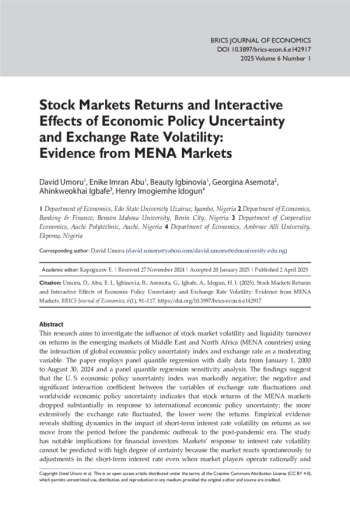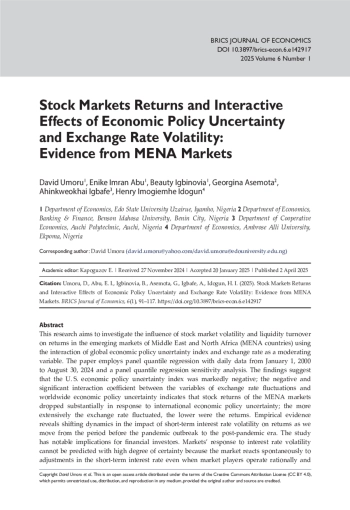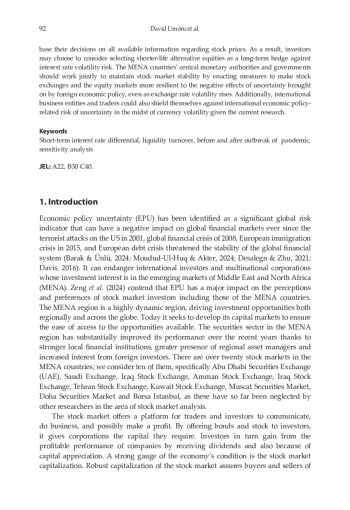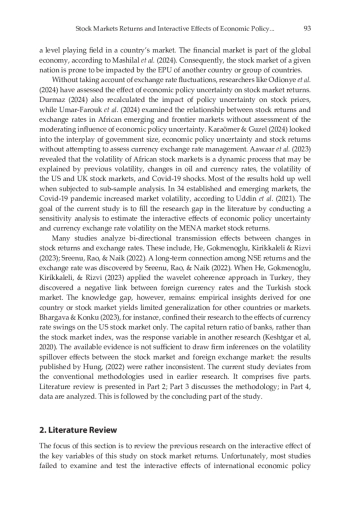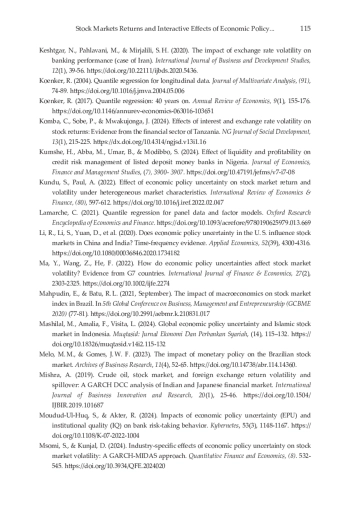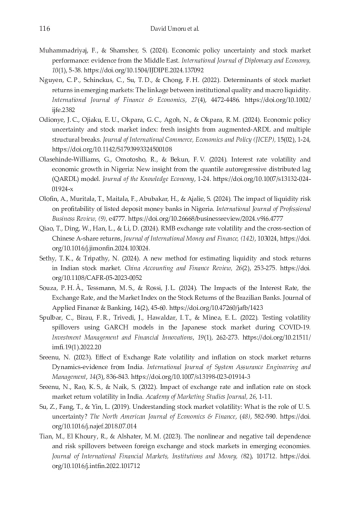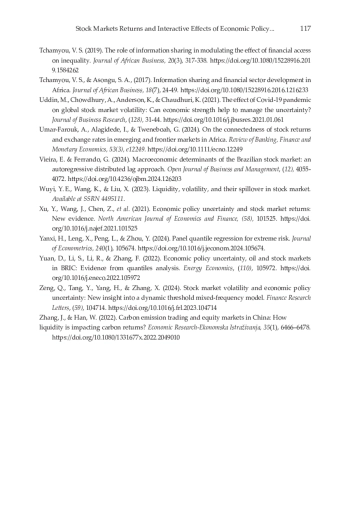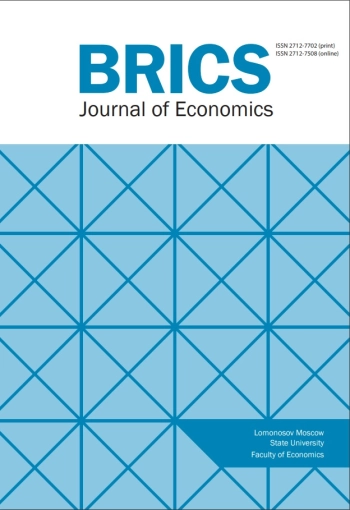This research aims to investigate the influence of stock market volatility and liquidity turnover on returns in the emerging markets of Middle East and North Africa (MENA countries) using the interaction of global economic policy uncertainty index and exchange rate as a moderating variable. The paper employs panel quantile regression with daily data from January 1, 2000 to August 30, 2024 and a panel quantile regression sensitivity analysis. The findings suggest that the U. S. economic policy uncertainty index was markedly negative; the negative and significant interaction coefficient between the variables of exchange rate fluctuations and worldwide economic policy uncertainty indicates that stock returns of the MENA markets dropped substantially in response to international economic policy uncertainty; the more extensively the exchange rate fluctuated, the lower were the returns. Empirical evidence reveals shifting dynamics in the impact of short-term interest rate volatility on returns as we move from the period before the pandemic outbreak to the post-pandemic era. The study has notable implications for financial investors. Markets’ response to interest rate volatility cannot be predicted with high degree of certainty because the market reacts spontaneously to adjustments in the short-term interest rate even when market players operate rationally and base their decisions on all available information regarding stock prices. As a result, investors may choose to consider selecting shorter-life alternative equities as a long-term hedge against interest rate volatility risk. The MENA countries’ central monetary authorities and governments should work jointly to maintain stock market stability by enacting measures to make stock exchanges and the equity markets more resilient to the negative effects of uncertainty brought on by foreign economic policy, even as exchange rate volatility rises. Additionally, international business entities and traders could also shield themselves against international economic policy-related risk of uncertainty in the midst of currency volatility given the current research.
Идентификаторы и классификаторы
Economic policy uncertainty (EPU) has been identified as a significant global risk indicator that can have a negative impact on global financial markets ever since the terrorist attacks on the US in 2001, global financial crisis of 2008, European immigration crisis in 2015, and European debt crisis threatened the stability of the global financial system (Barak & Ünlü, 2024; Moudud-Ul-Huq & Akter, 2024; Desalegn & Zhu, 2021; Davis, 2016). It can endanger international investors and multinational corporations whose investment interest is in the emerging markets of Middle East and North Africa (MENA). Zeng et al. (2024) contend that EPU has a major impact on the perceptions and preferences of stock market investors including those of the MENA countries. The MENA region is a highly dynamic region, driving investment opportunities both regionally and across the globe. Today it seeks to develop its capital markets to ensure the ease of access to the opportunities available. The securities sector in the MENA region has substantially improved its performance over the recent years thanks to stronger local financial institutions, greater presence of regional asset managers and increased interest from foreign investors. There are over twenty stock markets in the MENA countries; we consider ten of them, specifically Abu Dhabi Securities Exchange (UAE), Saudi Exchange, Iraq Stock Exchange, Amman Stock Exchange, Iraq Stock Exchange, Tehran Stock Exchange, Kuwait Stock Exchange, Muscat Securities Market, Doha Securities Market and Borsa Istanbul, as these have so far been neglected by other researchers in the area of stock market analysis.
Список литературы
- Aawaar, G., Logogye, L., & Domeher, D. (2023). Equity return volatility in Africa’s stock markets: A dynamic panel approach. Cogent Economics & Finance, 11(2), 2258704. https://doi.org/10.1080/23322039.2023.2258704
- Adam, N., Sidek, N. Z. M., & Sharif, A. (2022). The impact of global economic policy uncertainty and volatility on stock markets: Evidence from Islamic countries. Asian Economic and Financial Review, 12(1), 15-28. https://doi.org/10.18488/5002.v12i1.4400
- Agoba, A. M., Abor, J. Y., Osei, K. A., & Sa-Aadu, J. (2020). The independence of central banks, political institutional quality and financial sector development in Africa. Journal of Emerging Market Finance, 19(2), 154-188. https://doi.org/10.1177/0972652719877474
- Ahiadorme, J. W., Sonyo, E., & Ahiase, G. (2019). Time series analysis of interest rates volatility and stock returns in Ghana. Emerging Economy Studies, 5(2), 89-102.https://doi. org/10.1177/2394901519870765.
- Ahir, H., Bloom, N., & Furceri, D. (60). Years of uncertainty. Finance & Development, 57(1), 58-60.
- Ahir, H., Bloom, N., & Furceri, D. (2022). The world uncertainty index (No. w29763). National bureau of economic research.
- Aregbesola, O. D., Wright, O., Kolawole, I. T., Omojola, S. O. (2024). Impact of liquidity risk and leverage on the financial performance of Nigerian deposit money banks. JEFMS Journal, 7(8),
- 4867-4876. https://doi.org/10.47191/jefms/v7-i8-10 Asafo-Adjei, E., Agyapong, D., Agyei, S. K., Frimpong, S., Djimatey, R., & Adam, A. M. (2020).
- Economic policy uncertainty and stock returns of Africa: a wavelet coherence analysis. Discrete
- Dynamics in Nature and Society, 2020(1), 8846507. https://doi.org/10.1155/2020/8846507
- Asongu, S. A., (2020a). Technology, Education, Life and Non-life Insurance in Africa. International Journal of Public Administration, 43(11), 915-925. https://doi.org/10.1080/01900692.2019.1660994
- Asongu, S. A., (2020b). Financial access and productivity dynamics in sub-Saharan Africa. International Journal of Public Administration, 43(12), 1029-1041. https://doi.org/10.1080/01900 692.2019.1664570
- Awotunde, A., Asamu, A., Ogbebor, P. I., & Wale-awe, I. (2024). Exchange rate volatility and stock market capitalization in Nigeria. Seybold Report Journal, 19(03), 250-269. https://doi. org/10.5110/77.1132
- Barak, D., & Ünlü, M. (2024). Economic policy uncertainty and remittance nexus: evidence from top 10 remittance-receiving countries. Politická ekonomie, 72(4), 653-675, https://doi. org/10.18267/j.polek.1430
- Bhargava, V., & Konku, D. (2023). Impact of exchange rate fluctuations on US stock market returns. Managerial finance, 49(10), 1535-1557. https://doi.org/10.1108/mf-08-2022-0387
- Brambor, T., Clark, W. M., & Golder, M., (2006). Understanding interaction models: improving empirical analyses. Political Analysis, 14(1), 63-82.
- Bouazizi, T., Mrad, F., Hamida, A., & Nafti, S. (2022). Effects of conditional oil volatility on exchange rate and stock markets returns. International Journal of Energy Economics and
- Policy, 12(2), 53-71. https://doi.org/10.32479/ijeep.12826
- Cheng, S., Liu, W., Jiang, Q., & Cao, Y. (2023). Multi-scale risk connectedness between economic policy uncertainty of China and global oil prices in time-frequency domains. Comput Econ, 61(4), 1593-1616. https://doi.org/10.1007/s10614-022-10254-6
- Chiang, T. C. (2021). Geopolitical risk, economic policy uncertainty and asset returns in Chinese financial markets. China Finance Review International, 11(4), 474–501. https://doi.org/10.1108/ CFRI-08-2020-0115
- Dash, S. R., Maitra, D., Debata, B., et al. (2021). Economic policy uncertainty and stock market liquidity: Evidence from G7 countries. International Review of Finance, 21(2), 611-626. https://doi.org/10.1111/irfi.12277
- Davis, S. J. (2016). An index of global economic policy uncertainty (No. w22740). National Bureau of Economic Research..
- Desalegn, T. A., & Zhu, H. (2021). Does economic policy uncertainty affect bank earnings opacity? Evidence from China. Journal of Policy Modeling, 43(5), 1000-1015. https://doi.org/10.1016/j.jpolmod.2021.03.006.
- Dewanti, L. A., Rusmita, S. A., & Samad, K. (2022). Sensitivity Islamic stock return in Asia: the effect of exchange rate volatility. Journal of Islamic Economics and Business, 8(2), 302-317. https://doi.org/10.20473/jebis.v8i2.39018
- Durmaz, N. (2024). The effects of policy uncertainty on stock prices: revisiting with selected countries. Ekonomika, 103(3), 57- 69. DOI: https://doi.org/10.15388/Ekon.2024.103.3.4
- Gu, J. & Volgushev, S. (2019). Panel data quantile regression with grouped fixed effects. Journal of Econometrics, 213(1), 68-91. https://doi.org/10.1016/j.jeconom.2019.04.006
- Guler, D. (2020). The impact of the exchange rate volatility on the stock return volatility in Turkey. Eurasian Journal of Business and Management, 8(2), 106-123.
- Gyamerah, S. A., Agbi-Kaiser, H. O., Asare, C., & Dzupire, N. (2024). Asymmetric impact of heterogenous uncertainties on the green bond market. Discrete Dynamics in Nature and Society, 2024(1), 6644658. https://doi.org/10.1155/2024/6644658
- He, X., Gokmenoglu, K. K., Kirikkaleli, D., & Rizvi, S. K. A. (2023). Co‐movement of foreign exchange rate returns in an emerging market: Evidence from the wavelet coherence approach. International Journal of Finance & Economics, 28(2), 1994-2005. https://doi.org/10.1002/ijfe.2522
- Herley, M. D., Orlowski, L. T., & Ritter, M. A. (2023). Asymmetric responses of equity returns to changes in exchange rates at different market volatility levels, The Journal of Economic Asymmetries, (28), e00336. https://doi.org/10.1016/j.jeca.2023.e00336.
- Hung, N. T. (2022). Spillover effects between stock prices and exchange rates for the central and eastern European countries. Global Business Review, 23(2), 259-286. https://doi.org/10.1177/0972150919869772
- Istiak, K., Alam, M. R. (2020). US economic policy uncertainty spillover on the stock markets of the GCC countries. Journal of Economic Studies, 47(1), 36-50. https://doi.org/ 10.1108/JES-11-2018-0388
- Kannadhasan, M., & Das, D. (2020). Do Asian emerging stock markets react to international economic policy uncertainty and geopolitical risk alike? A quantile regression approach. Finance Research Letters, (34), 101276. https://doi.org/10.1016/j.frl.2019.08.024
- Karaömer, Y., & Guzel, A. E. (2024). Effect of economic policy uncertainty on stock returns: analyzing the moderating role of government size. Politická ekonomie, 72(1), 50-72, https://doi.org/10.18267/j.polek.1407
- Katembo, A. (2024). Effect of interest rate changes on stock market volatility in Congo. American Journal of Finance, 10(3), 1–12. https://doi.org/10.47672/ajf.2168.
- Kato, K., Galvao, A. F., & Montes-Rojas, G. (2012). Asymptotics for panel quantile regression models with individual effects. Journal of Econometrics, (170), 76-91. https://doi.org/10.1016/j.jeconom.2012.02.007
- Keshtgar, N., Pahlavani, M., & Mirjalili, S. H. (2020). The impact of exchange rate volatility on banking performance (case of Iran). International Journal of Business and Development Studies, 12(1), 39-56. https://doi.org/10.22111/ijbds.2020.5436.
- Koenker, R. (2004). Quantile regression for longitudinal data. Journal of Multivariate Analysis, (91), 74-89. https://doi.org/10.1016/j.jmva.2004.05.006
- Koenker, R. (2017). Quantile regression: 40 years on. Annual Review of Economics, 9(1), 155-176. https://doi.org/10.1146/annurev-economics-063016-103651
- Komba, C., Sobe, P., & Mwakujonga, J. (2024). Effects of interest and exchange rate volatility on stock returns: Evidence from the financial sector of Tanzania. NG Journal of Social Development, 13(1), 215-225. https://dx.doi.org/10.4314/ngjsd.v13i1.16
- Kumshe, H., Abba, M., Umar, B., & Modibbo, S. (2024). Effect of liquidity and profitability on credit risk management of listed deposit money banks in Nigeria. Journal of Economics, Finance and Management Studies, (7), 3900- 3907. https://doi.org/10.47191/jefms/v7-i7-08
- Kundu, S., Paul, A. (2022). Effect of economic policy uncertainty on stock market return and volatility under heterogeneous market characteristics. International Review of Economics &
- Finance, (80), 597-612. https://doi.org/10.1016/j.iref.2022.02.047
- Lamarche, C. (2021). Quantile regression for panel data and factor models. Oxford Research
- Encyclopedia of Economics and Finance. https://doi.org/10.1093/acrefore/9780190625979.013.669
- Li, R., Li, S., Yuan, D., et al. (2020). Does economic policy uncertainty in the U. S. influence stock markets in China and India? Time-frequency evidence. Applied Economics, 52(39), 4300-4316. https://doi.org/10.1080/00036846.2020.1734182
- Ma, Y., Wang, Z., He, F. (2022). How do economic policy uncertainties affect stock market volatility? Evidence from G7 countries. International Journal of Finance & Economics, 27(2), 2303-2325. https://doi.org/10.1002/ijfe.2274
- Mahpudin, E., & Batu, R. L. (2021, September). The impact of macroeconomics on stock market index in Brazil. In 5th Global Conference on Business, Management and Entrepreneurship (GCBME 2020) (77-81). https://doi.org/10.2991/aebmr.k.210831.017
- Mashilal, M., Amalia, F., Visita, L. (2024). Global economic policy uncertainty and Islamic stock market in Indonesia. Muqtasid: Jurnal Ekonomi Dan Perbankan Syariah, (14), 115–132. https:// doi.org/10.18326/muqtasid.v14i2.115-132
- Melo, M. M., & Gomes, J. W. F. (2023). The impact of monetary policy on the Brazilian stock market. Archives of Business Research, 11(4), 52-65. https://doi.org/10.14738/abr.114.14360.
- Mishra, A. (2019). Crude oil, stock market, and foreign exchange return volatility and spillover: A GARCH DCC analysis of Indian and Japanese financial market. International
- Journal of Business Innovation and Research, 20(1), 25-46. https://doi.org/10.1504/ IJBIR.2019.101687
- Moudud-Ul-Huq, S., & Akter, R. (2024). Impacts of economic policy uncertainty (EPU) and institutional quality (IQ) on bank risk-taking behavior. Kybernetes, 53(3), 1148-1167. https:// doi.org/10.1108/K-07-2022-1004
- Msomi, S., & Kunjal, D. (2024). Industry-specific effects of economic policy uncertainty on stock market volatility: A GARCH-MIDAS approach. Quantitative Finance and Economics, (8). 532- 545. https://doi.org/10.3934/QFE.2024020
- Muhammadriyaj, F., & Shamsher, S. (2024). Economic policy uncertainty and stock market performance: evidence from the Middle East. International Journal of Diplomacy and Economy, 10(1), 5-38. https://doi.org/10.1504/IJDIPE.2024.137092
- Nguyen, C. P., Schinckus, C., Su, T. D., & Chong, F. H. (2022). Determinants of stock market returns in emerging markets: The linkage between institutional quality and macro liquidity. International Journal of Finance & Economics, 27(4), 4472-4486. https://doi.org/10.1002/ijfe.2382
- Odionye, J. C., Ojiaku, E. U., Okpara, G. C., Agoh, N., & Okpara, R. M. (2024). Economic policy uncertainty and stock market index: fresh insights from augmented-ARDL and multiple structural breaks. Journal of International Commerce, Economics and Policy (JICEP), 15(02), 1-24, https://doi.org/10.1142/S1793993324500108
- Olasehinde-Williams, G., Omotosho, R., & Bekun, F. V. (2024). Interest rate volatility and economic growth in Nigeria: New insight from the quantile autoregressive distributed lag (QARDL) model. Journal of the Knowledge Economy, 1-24. https://doi.org/10.1007/s13132-024-01924-x
- Olofin, A., Muritala, T., Maitala, F., Abubakar, H., & Ajalie, S. (2024). The impact of liquidity risk on profitability of listed deposit money banks in Nigeria. International Journal of Professional Business Review, (9), e4777. https://doi.org/10.26668/businessreview/2024.v9i6.4777
- Qiao, T., Ding, W., Han, L., & Li, D. (2024). RMB exchange rate volatility and the cross-section of Chinese A-share returns, Journal of International Money and Finance, (142), 103024, https://doi.org/10.1016/j.jimonfin.2024.103024.
- Sethy, T. K., & Tripathy, N. (2024). A new method for estimating liquidity and stock returns in Indian stock market. China Accounting and Finance Review, 26(2), 253-275. https://doi.org/10.1108/CAFR-05-2023-0052
- Souza, P. H. Â., Tessmann, M. S., & Rossi, J. L. (2024). The Impacts of the Interest Rate, the Exchange Rate, and the Market Index on the Stock Returns of the Brazilian Banks. Journal of Applied Finance & Banking, 14(2), 45-60. https://doi.org/10.47260/jafb/1423
- Spulbar, C., Birau, F. R., Trivedi, J., Hawaldar, I. T., & Minea, E. L. (2022). Testing volatility spillovers using GARCH models in the Japanese stock market during COVID-19. Investment Management and Financial Innovations, 19(1), 262-273. https://doi.org/10.21511/imfi.19(1).2022.20
- Sreenu, N. (2023). Effect of Exchange Rate volatility and inflation on stock market returns Dynamics-evidence from India. International Journal of System Assurance Engineering and Management, 14(3), 836-843. https://doi.org/10.1007/s13198-023-01914-3
- Sreenu, N., Rao, K. S., & Naik, S. (2022). Impact of exchange rate and inflation rate on stock market return volatility in India. Academy of Marketing Studies Journal, 26, 1-11.
- Su, Z., Fang, T., & Yin, L. (2019). Understanding stock market volatility: What is the role of U. S. uncertainty? The North American Journal of Economics & Finance, (48), 582-590. https://doi.org/10.1016/j.najef.2018.07.014
- Tian, M., El Khoury, R., & Alshater, M. M. (2023). The nonlinear and negative tail dependence and risk spillovers between foreign exchange and stock markets in emerging economies. Journal of International Financial Markets, Institutions and Money, (82), 101712. https://doi.org/10.1016/j.intfin.2022.101712
- Tchamyou, V. S. (2019). The role of information sharing in modulating the effect of financial access on inequality. Journal of African Business, 20(3), 317-338. https://doi.org/10.1080/15228916.201 9.1584262
- Tchamyou, V. S., & Asongu, S. A., (2017). Information sharing and financial sector development in Africa. Journal of African Business, 18(7), 24-49. https://doi.org/10.1080/15228916.2016.1216233
- Uddin, M., Chowdhury, A., Anderson, K., & Chaudhuri, K. (2021). The effect of Covid-19 pandemic on global stock market volatility: Can economic strength help to manage the uncertainty? Journal of Business Research, (128), 31-44. https://doi.org/10.1016/j.jbusres.2021.01.061
- Umar-Farouk, A., Alagidede, I., & Tweneboah, G. (2024). On the connectedness of stock returns and exchange rates in emerging and frontier markets in Africa. Review of Banking, Finance and Monetary Economics, 53(3), e12249. https://doi.org/10.1111/ecno.12249
- Vieira, E. & Ferrando, G. (2024). Macroeconomic determinants of the Brazilian stock market: an autoregressive distributed lag approach. Open Journal of Business and Management, (12), 4055- 4072. https://doi.org/10.4236/ojbm.2024.126203
- Wuyi, Y. E., Wang, K., & Liu, X. (2023). Liquidity, volatility, and their spillover in stock market. Available at SSRN 4495111.
- Xu, Y., Wang, J., Chen, Z., et al. (2021). Economic policy uncertainty and stock market returns: New evidence. North American Journal of Economics and Finance, (58), 101525. https://doi. org/10.1016/j.najef.2021.101525
- Yanxi, H., Leng, X., Peng, L., & Zhou, Y. (2024). Panel quantile regression for extreme risk. Journal of Econometrics, 240(1), 105674. https://doi.org/10.1016/j.jeconom.2024.105674.
- Yuan, D., Li, S., Li, R., & Zhang, F. (2022). Economic policy uncertainty, oil and stock markets in BRIC: Evidence from quantiles analysis. Energy Economics, (110), 105972. https://doi. org/10.1016/j.eneco.2022.105972
- Zeng, Q., Tang, Y., Yang, H., & Zhang, X. (2024). Stock market volatility and economic policy uncertainty: New insight into a dynamic threshold mixed-frequency model. Finance Research
- Letters, (59), 104714. https://doi.org/10.1016/j.frl.2023.104714
- Zhang, J., & Han, W. (2022). Carbon emission trading and equity markets in China: How liquidity is impacting carbon returns? Economic Research-Ekonomska Istraživanja, 35(1), 6466–6478. https://doi.org/10.1080/1331677x.2022.2049010
Выпуск
Другие статьи выпуска
The paper presents an empirical study of the relationships between financial development, economic growth, urbanisation and energy consumption in the Southern African Development Community for the years 1980 to 2023. The researchers applied the Bayesian approach via Metropolis-Hasting and Gibbs samples as the MCMC methods, and Dumitrescu and Hurlin (2012) and Diagnostic tests to check the causality among all the variables in question and accuracy of the data and model. Over time, there has been a significant positive correlation between financial development, economic growth, industrialization, urbanization, and energy consumption. The results of the Granger causality test showed a unidirectional causal relationship between financial development, urbanization, and energy consumption supporting the alternative hypothesis that there is a relationship between financial development and energy consumption in the Southern African Development Community. It has been found that there is a Bi-directional (feedback) Granger causal relationship between economic growth and energy consumption in the Southern African Development Community; this also supports the alternative hypothesis. The results align with endogenous growth theory, which emphasizes that economic growth is driven by internal factors such as capital accumulation, innovation, and improved efficiencies, where energy plays a significant role. This also supports the view that energy infrastructure development is vital for sustaining economic growth in the region. The diagnostic tests confirm that the model is correct.
This paper examines the sharing economy as an advanced model of interaction between economic agents that helps them mitigate resource constraints and rapidly meet producers’ and consumers’ needs in the face of new challenges. We found the benefits of collaborative consumption, or sharing, to be largely determined by the level of trust in society, development of technological base and adaptation of legal framework to digital transformation of the national economy. Based on the evidence from Russia and Brazil, we classify the factors that determine the sharing economy development and identify effective instruments of regulating sharing relations. The results indicate that regulatory “sandboxes” appear to be most appropriate as they allow participants to test innovations of substantial public importance that lie outside the scope of existing legislative norms.
This study investigates how small and medium-sized enterprises (SMEs) achieve and manage innovative ambidexterity through their dynamic capability, addressing potential imbalances in changing environments under resource constraints. Employing a comparative case study approach, the research draws on qualitative, in-depth interviews with CEOs and founders of four Russian SMEs operating in the Information Technology (IT) sector, selected from a larger cohort. Key capabilities were identified for each phase of the dynamic capability process. In the sensing phase, essential capabilities include cultivating dynamic technological and marketing skills, problem-solving proficiency and commitment to continuous learning with real-time awareness. In the seizing phase, the emphasis shifts to enhancing capabilities through learning, fostering innovation-driven culture, empowering employees, providing continuous training, promoting active collaboration at all levels, and recognizing achievements through team rewards. During the reconfiguration phase, adaptive decision-making, resource and coordination flexibility and future-oriented innovation and partnerships become critical. These capabilities contribute to a balance of exploratory and exploitative innovation within SMEs enabling the achievement of innovative ambidexterity. Throughout this process, potential imbalances are managed by leveraging critical capabilities such as clear goal-setting and performance feedback, culture of openness, trust, and mutual support, and adaptive decision-making with wise allocation of firm-specific resources. Through our findings, we advance the understanding that ambidexterity is achievable for resource-constrained SMEs in uncertain environment under external constraints, offering insights into dynamic capabilities that enable such attainment.
The paper explores the role of external mentoring as a strategic talent attraction tool in the context of talent shortages and describes the ways in which it can help firms to find new candidates, especially among young graduates, at the same time developing its own employees. The authors conducted 21 in-depth interviews with experienced mentors from multinational companies in Russia and one expert interview. Content analysis was used to identify the key themes related to the effectiveness of external mentoring. External mentoring significantly enhances employer branding, knowledge exchange, learning and professional development. The critical components of success are voluntary participation, non-monetary recognition and long-term trust-based relationships between mentors and mentees. The paper also identifies the challenges that external mentoring may encounter and essential criteria for selecting mentors and mentees. The authors conceptualize external mentoring as a novel approach to talent attraction extending beyond internal employee development. The study provides fresh insights into resolving talent shortages and creating external talent pools, thus contributing to talent management and mentoring literature.
The Belt and Road Initiative (BRI) has garnered significant attention over the past decade. This expansive project promises lucrative opportunities and a potential boost to global trade. However, infrastructure, policy, and strategic challenges pose risks to its international success. This study examines the forces driving the growth of e-commerce supply chain companies participating in the BRI, focusing on China and Russia as research context. Using the Value Chain theory, we explain how combination of its primary and support activities influences the development of international supply chains within the BRI. We employ a multilinear regression model to test the proposed framework, with an ANOVA model to verify the robustness of our findings. The results reveal that primary and support activities have different significance within BRI collaboration. Exogenous factors, particularly industrial and municipal policies, as well as infrastructural development, are the key drivers of e-commerce success in the BRI supply chains. This study contributes to the growing body of literature on the BRI by providing empirical evidence of the factors influencing e-commerce growth in participating countries. Our findings offer insights for firms and policymakers seeking to capitalize on the opportunities presented by the BRI and highlight the areas requiring attention to ensure its long-term viability and success.
Stabilizing the Consumer Price Index (CPI) to protect the populace from the adverse effects of inflation necessitates appropriate measures at both political and economic governance levels. This study examines the impacts of imports (IM) and exports (EX) on inflation (CPI) in Afghanistan using data from 1990 to 2023. The findings from the Autoregressive Distributed Lag (ARDL) model indicate that both IM and EX significantly impact CPI in the short and long term. A robustness check employing the Kernel-based Regularized Least Squares (KRLS) machine learning technique further validates these results. The analysis confirms that international trade has a substantial and positive effect on CPI. Additionally, in the context of Afghanistan, political instability acts as a positive moderator, amplifying the influence of imports and exports on inflation. The study concludes that the country requires a reevaluation of its policies regarding exchange rates and economic growth to mitigate the negative effects of imports, exports, and political volatility on the stability of the CPI.
The ongoing digital transformation provides an infrastructural basis for multi-level networking. The United States and China as the leaders in designing long-term social and economic development strategies pay serious attention to technological sovereignty and sustainable interaction between the corporate and public sectors that are impossible without reliable digital infrastructure. Digital platforms have become its most important component, creating prerequisites for the formation and development of various network structures. The paper discusses the subordinate effects resulting from the development of digital platforms as part of digitalization. Today, global value chains are being transformed, changing the global reproduction system; the reproduction process is also influenced by digital transformation; technological development and innovations bring new opportunities and transform all aspects of socioeconomic interaction. The methodological basis of the study is constituted by the system approach, comparative analysis and statistical methods. The paper examines the prospects of digital platforms in the PRC both for the national economy and international cooperation and proposes guidelines on their strategic development. It describes the specific features of financing their formation and systematizes the characteristics of networking in the sphere of e-commerce, cloud services and investment cooperation. Addressing the social aspect of using digital platforms, the study emphasizes the importance of social monitoring and migration controls that give the country a competitive advantage in developing and testing the technologies involved. It also shows that platform employment and digital poverty create multidirectional trends affecting the country’s economic development.
This paper concerns Corporate Social Responsibility (CSR) employer branding and its impact on employee attraction and retention, seeking to systematize academic knowledge about their interconnections and links to other important management issues. We made a systematic literature review focusing on empirical papers published in academic journals over the last 10 years, which enabled us to identify the directions of contemporary research, commonly used methodologies and contexts explored. It shows that CSR initiatives are increasingly recognized as a critical dimension of employer branding. Alignment of CSR practices and employer branding strategies is essential for attracting top talent. We also observed a strong link between CSR and employer attractiveness, career development, organizational identification, corporate reputation and person-organization fit, which underscores the multifaceted nature of CSR employer branding. It has been found that CSR researchers predominantly use quantitative methodologies in their studies and tend to explore the firms that work in the IT industry. The paper discusses the current state of CSR employer branding research and outlines possible avenues for future studies.
The paper investigates the relationship between corporate governance and organizational performance in Nigeria’s banking sector between 1996 and 2023, using the Tobin-Q valuation and operating performance methodology (quantitative characteristics) of variables in analyzing data collected from secondary sources.
The internal mechanisms of corporate governance such as Returns on Assets (ROA), shareholder profit and Debt-Equity ratio had a negative impact on organizational performance. The study into forecast and long-term co-integration relationship between corporate governance mechanisms and organizational performance has shown that the enhancement of organizational performance by corporate governance mechanisms is likely to experience a steady increase after 2023.
Economic landscape of Pakistan is determined by an extremely complex interaction of domestic and global forces; navigating it successfully requires a clear understanding of its character. The paper explores the dynamic relationships between macroeconomic variables and GDP growth in Pakistan using the Autoregressive Distributed Lag (ARDL) model and other stability tests using time series data from 1980 to 2022. The analysis includes variables representing GDP per capita, inflation, imports, total debt as a percentage of GDP, total population, and forestry and agricultural output. The correlation matrix shows a positive association between GDP growth rate and GDP per capita, total debt service is inversely correlated with total population, and GDP demonstrates a significant negative correlation. The ARDL results indicate that GDP per capita and the agriculture and forestry sectors are significant drivers of economic growth. Over the period in question, inflation only marginally affected GDP growth showing how important it is to maintain price stability through effective policies. Imports provide short-term benefits by enhancing productivity through capital goods and technology inflows but they may pose long-term challenges due to trade imbalances. The influence of population growth appears to be ambivalent: in the short term it contributes to economic growth by increasing labor supply and consumption; in the long term, however, its effect may become detrimental owing to resource constraints. Public debt shows little influence in the short term but negatively impacts growth over time by increasing the fiscal burden of debt servicing. These findings suggest that to achieve long-term economic stability and growth, the country needs targeted policy interventions that should help it control inflation, manage the debt sustainably, optimize imports, and invest in agriculture, which is an important determinant of GDP growth. Future research should concentrate on sector-specific studies and the effects of political stability on economic growth in order to provide deeper insights contributing to Pakistan’s sustainable economic development.
Статистика статьи
Статистика просмотров за 2025 год.
Издательство
- Издательство
- МГУ
- Регион
- Россия, Москва
- Почтовый адрес
- оссийская Федерация, 119991, Москва, Ленинские горы, д. 1
- Юр. адрес
- оссийская Федерация, 119991, Москва, Ленинские горы, д. 1
- ФИО
- Садовничий Виктор Антонович (РЕКТОР)
- E-mail адрес
- info@rector.msu.ru
- Контактный телефон
- +7 (495) 9391000
- Сайт
- https://msu.ru/
